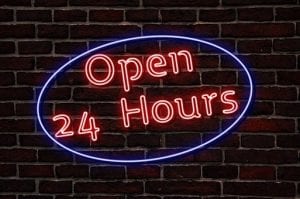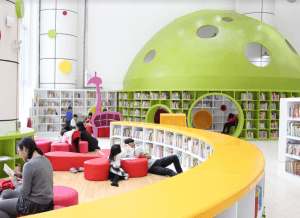The Worl d Wide Web, paired with devices which allow us to easily locate information, mean that we can find the answer to almost anything we want to know within seconds. When I was younger, I thought this was exciting, and in some ways, I still do. However, now that I am juggling life as an employee, a student, and a parent, I’m somewhat less impressed with the ability to be ‘connected’ all the time. In many ways, it actually feels like a burden.
d Wide Web, paired with devices which allow us to easily locate information, mean that we can find the answer to almost anything we want to know within seconds. When I was younger, I thought this was exciting, and in some ways, I still do. However, now that I am juggling life as an employee, a student, and a parent, I’m somewhat less impressed with the ability to be ‘connected’ all the time. In many ways, it actually feels like a burden.
When asked to consider some of the ramifications of having access to information at all times and to think about how this affects my ability as a student, I was quickly able to identify both positive and negative effects.
Advantages
- Immediate access – I really appreciate that if I come across a term that I am unfamiliar with in my studies, a quick internet search will usually enable me to locate several definitions of the term. If I need to do further reading, I am often able to locate more detailed information through academic journal articles online. This leads me to my next point.
- Convenient – I need not ever leave the comfort of my study in order to locate the information that I need. When I studied my first degree back in the early 2000’s, I didn’t have internet access in my home and I certainly didn’t have a smart phone. I walked to the university library and in most cases, looked for a physical copy of the book or journal that I needed. If I didn’t have the information I needed before the library closed, I’d have to wait until the next time it was open to find what I needed. Talk about inconvenient!
- Current – I enjoy how easily I am able to find both current and relevant academic journals and books online when studying.
Disadvantages
- Switching off – I mentioned previously that I enjoyed being able to access information around the clock rather than having to wait for the library to open. Unfortunately, this also means that because I know I can access this at any time, I find it difficult to ‘switch off’ during times when I should be focusing on other things. I think this is true for many people in general, and a definite negative affect of being constantly ‘connected’.
- Distraction – It’s a wonderful thing to have an inquiring mind and be able to search for, and locate information. Unfortunately, this also means that one must be very good at focusing on one task rather than becoming distracted and going on a different tangent…which I am guilty of on more than one occasion.
Ultimately, I enjoy having such ready access to information of all types, presented in various formats and delivery modes. The key for me is learning how to strike a balance between information searching/consumption and simply being without the constant need to ‘find the answer’.

Photo by Jamie Taylor on Unsplash
A library collection is reflective of the community in which it sits and the purpose for which it serves. Furthermore, it is an every evolving entity and has a life cycle which never ends (Hibner & Kelly, 2013, p.22). My experience with libraries as a classroom teacher has taught me that a library collection serves a broad range of groups and purposes, and as such, must contain a balance of resources, be they digital or analogue.
Despite spending many, many hours of my life in libraries, I am yet to work in one, so I was interested to do some further reading this week about developing collections. From my readings this week, I was surprised to learn that there is no one way to develop and manage a collection, but rather a variety of strategies that different libraries employ in order to best meet the diverse needs of the library community. In her book, Fundamentals of Collection Development and Management, Peggy Johnson (2009, p. 108) says:
Selection is both an art and a science.
Johnson (2009, p. 108) talks about the selection process being one which draws not only from knowledge and experience, but also intuition. She also says that the mastery of collection management is developed by the repeated and frequent practice of collection building. This idea challenged my thinking as I had, presumably incorrectly, assumed the the collection of books must follow and adhere to a specific policy. I had also assumed that when a collection policy was written, that’s how it would stay. However, Hibner and Kelly (2013, p. 24) suggest that just like the collection, the collection management policy must also be regularly updated in order for it to be of use. Initially, I wondered what they purpose of a collection policy would be if it was going to constantly change, however upon reflection, I came to understand that as budgets and resources change regularly, so too must the collection policy if it is going to remain current.
As another week passes, I am reminded of just how little I know and how much more I need to learn about the complexities of collection management and maintenance.
References
Hibner, Holly, and Mary Kelly. Making a Collection Count : A Holistic Approach to Library Collection Management, Elsevier Science & Technology, 2013. ProQuest Ebook Central, https://ebookcentral.proquest.com/lib/csuau/detail.action?docID=1575569.
Johnson, P. (2009). Fundamentals of Collection Development and Management (Vol. 2nd ed). Chicago: ALA Editions. Retrieved from http://ezproxy.csu.edu.au/login?url=http://search.ebscohost.com/login.aspx?direct=true&db=nlebk&AN=267756&site=ehost-live
 Collection Management
Collection Management
One of the many roles of the teacher librarian is to develop and manage the library collection. In the rapidly changing digital climate, this task is a complex and ever-evolving one, and requires constant evaluation and consideration.
The National Library of New Zealand states that:
A library collection is made up of all of the physical and electronic items that have been curated with a specific audience and purpose in mind.
To develop and maintain this collection, the librarian must undertake a series of tasks which include:
- Identifying and planning for potential and available resources
- Select resources
- Organising resources
- Evaluate resources
- Deselect resources, commonly know as weeding
-National Library of New Zealand: Collections and Collection management
This week was my first introduction to library collection management. In addition to learning about some of the main tasks involved in collection development and management, I was also introduced to some of the challenges that come as part of this task. Unsurprisingly, budget, technology and a continually evolving curriculum were identified, but one challenge which I had not previously considered was that of ethics. A school’s code of ethics may very well restrict what can be included in a library collection, information which I found both interesting and valuable to know.
References
National Library of New Zealand: Collections and collection management (n.d.). Retrieved from https://natlib.govt.nz/schools/school-libraries/collections-and-resources/collections-and-collection-management

I have always had a deep love of quality children’s literature and have been an avid reader since I was a child. I attended a rural school in country Victoria and one of my fondest memories was visiting the mobile library to borrow books each month. My love of books continued as I became a classroom teacher and I never missed an opportunity to incorporate literature into my lessons to support my teaching. I truly believe that whatever the subject, there is always a text to be found which will enhance my teaching and the student’s learning.
When I first decided that I wanted to make the transition from classroom teacher to teacher librarian, I imagined myself reading stories to the students, helping them learn how to select appropriate reading material and inspiring the students to become active and avid readers and information seekers. I dreamt about creating magical nooks within the library for students to settle into with their favourite books where they could travel to far away places or learn about something new that makes their world the incredible place that it is. In my role as a classroom teacher, I have had very little to do with the teacher librarian, in any school, so I was somewhat surprised to learn what a teacher librarian’s role entailed.
The role of the teacher librarian in the 21st century
In a rapidly changing world where there is an app for every imaginable task, where one can access reading material 24/7 and where anyone can publish their own thoughts and ideas for the world to see, the role of the teacher librarian is a complex one, and vastly different to what it used to be.
“Teacher librarians support and implement the vision of their school communities through advocating and building effective library and information services and programs that contribute to the development of lifelong learners”.
(Australian School Library Association, 2014, p. 1).
The Australian School Library Association (2014, p. 1) identifies three major roles of the teacher librarian which include:
- being a leader within the school
- being a highly skilled information specialist
- being an information service manager
A 21st century librarian is an information expert and use their expertise to ‘enhance digital and information literacy, resource the curriculum and help students become critical, creative and collaborative thinkers’ (ACT Government Education Directorate, 2012, p. 3). They are curriculum experts who work with teachers to help them effectively embed ICT skills into their lessons, whilst at the same time teaching the students to be discerning information gatherers and users.
My misconceptions
My initial understanding of the role of the teacher librarian has already shifted fundamentally in the past few weeks. The role of the teacher librarian is not a simple one, but rather, a multi-faceted and highly significant one. The teacher librarian in an expert in curriculum, leadership, pedagogy, collection management and digital literacy, among other things. The mere fact that I had little idea what our school librarian does tells me that there is much work to be done, at least in my own workplace, around the promotion of the amazing work that teacher librarians do and the invaluable resource that they are to our school communities.
References
ACT Government Education Directorate. (2012). School Libraries: The heart of 21st century learning. Retrieved from: https://www.education.act.gov.au/__data/assets/pdf_file/0020/916301/School-Libraries-21st-Century.pdf
Australian School Library Association (2014) What is a teacher librarian? Retrieved from
http://www.asla.org.au/advocacy/what-is-a-teacher-librarian.aspx
Digital curation tools are a way for people to collect, organise and share online artifacts. With the rapid growth of information available on the Internet, digital tools provide users with a succinct way in which to search for, store and share categorized information (Flintoff, Mellow & Picket Clark: 2014).
Jenkins et.al (2009) suggests that digital curation enables ‘average users’ to engage more easily with media content, something which I can relate to. Until recently, my use of curation tools has been limited mostly to Pinterest. This curation tool met my needs perfectly from both a personal and professional standpoint. It’s easy to use and is visually very appealing so that’s the tool I have been using. Last year, I added ScoopIt! to my list of curation tools for professional purposes. ScoopIt! allows you to annotate each online artifact, making it perfect for digital annotated bibliographies.
In my search for digital curation tools, I came across a fantastic website called Cool Tools For School which has some useful reading materials on curation tools and a great round up of digital curation tools that can be used in the classroom. If you’re a beginner like myself, this is a great place to visit.
As I have begun exploring the range of curation tools available, one of the things that I have learnt is that some of these tools have features which allow them to be used as a way in which to collaborate with others, thus enabling one to create ‘professional learning networks’ (Flintoff et al: 2014). Scoop.It is one such curation tool that has this feature. I’m yet to use it for this purpose so I am keen to revisit it again.
This week, I began exploring the curation tool Diigo.I have never heard of this before now however it is quite simple to save information from the Internet and I can see that this will be useful tool going forwards. It has a collaborative element to it and my goal in the coming week will be to learn how to use this function in a meaningful way that will support my learning and teaching.
References
Flintoff, K., Mellow, P. & Pickett Clark, K. (2014). Digital curation: Opportunities for learning, teaching, research and professional development. In Transformative, innovative and engaging. Proceedings of the 23rd Annual Teaching Learning Forum, 30-31 Jan. 2014, Perth: The University of Western Australia.
Jenkins, H., Purushotma, R., Weigel, M., Clinton, K. & Robinson, A. J. (2009). Confronting the
challenges of participatory culture: Media education for the 21st Century. A report for the
MacArthur Foundation. Boston: MIT Press. http://mitpress.mit.edu/sites/default/files/titles/free_
download/9780262513623_Confronting_the_Challenges.pdf
 d Wide Web, paired with devices which allow us to easily locate information, mean that we can find the answer to almost anything we want to know within seconds. When I was younger, I thought this was exciting, and in some ways, I still do. However, now that I am juggling life as an employee, a student, and a parent, I’m somewhat less impressed with the ability to be ‘connected’ all the time. In many ways, it actually feels like a burden.
d Wide Web, paired with devices which allow us to easily locate information, mean that we can find the answer to almost anything we want to know within seconds. When I was younger, I thought this was exciting, and in some ways, I still do. However, now that I am juggling life as an employee, a student, and a parent, I’m somewhat less impressed with the ability to be ‘connected’ all the time. In many ways, it actually feels like a burden.
 Collection Management
Collection Management
